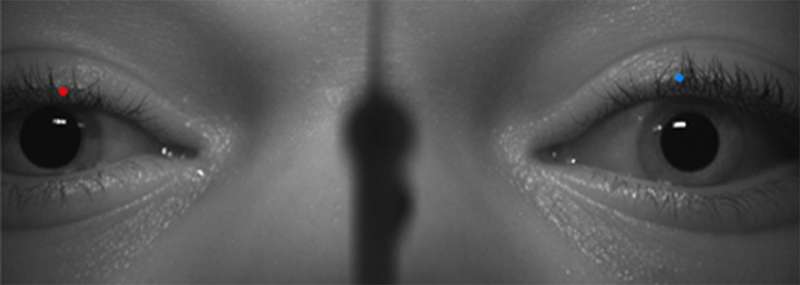Neurological assessment in the blink of an eye?

A novel technology developed by the Zucker Institute for Applied Neurosciences at the Medical University of South Carolina was able to measure the blink response comparably to electromyography in a validation study of ten healthy college students, according to an article published online on Dec. 12, 2017 by the IEEE Journal of Translational Engineering in Health and Medicine. The blink response can be an important indicator of neurological status.
The blink reflex has been shown to be sensitive to a number of neurological insults, including traumatic brain injury, Parkinson's disease and Huntington's disease, suggesting that it could be a useful tool for neurological assessment. Although electromyography (EMG)-derived time metrics were used to analyze the blink reflex as early as the 1950s, quantitative assessment of the blink response was never adopted widely in clinical practice, in part because existing technology was somewhat cumbersome and uncomfortable. Moreover, EMG is a highly sensitive technology requiring strict ambient parameters and was not easily performed outside the health care setting, limiting the applications of the blink reflex as a diagnostic indicator of neurological health. Advances in video and computer technology—including improved digital image capture, higher frame speeds and higher processing speeds—have now put portable, noninvasive, quantitative assessment of the blink within reach.
The Blink Reflexometer, a portable device developed by the Zucker Institute for Applied Neurosciences at the Medical University of South Carolina that has since been licensed to BLINKtbi (Charleston, SC), uses high-speed video to capture and quantitatively analyze a series of blinks that it stimulates with puffs of air. The device analyzes the recorded blinks based on data acquired from decades of blink reflex research to determine if the patient has experienced neurological insult.
In a validation study in ten healthy college students, the results of which were reported in an article published online December 12, 2017 by the IEEE Journal of Translational Engineering in Health and Medicine, a team of investigators at the Medical University of South Carolina and The Citadel obtained blink measurements for ten healthy college students using the Blink Reflexometer and compared them to published measurements obtained with EMG. Three parameters were measured: latency (time between stimulus to first eyelid movement), differential latency (difference in start time between eyelids) and duration (time from start of eyelid movement to eyelid open). Latency and duration measurements obtained with the Blink Reflexometer were in line with published results; only differential latency fell outside of published ranges. These findings suggest that the Blink Reflexometer can provide quantitative measurements of the blink that are on par with those obtained via EMG.
"We are excited to be able to take something that had been qualitative and make it quantitative and objective," says lead author Nancey Trevanian Tsai, M.D. "We talk about metrics all the time in medicine but when you are actually able to provide quantitative, objective data, it's a game changer. It's analogous to the difference between saying someone is feverish to measuring the patient's temperature, an objective measurement, with a thermometer."
This study was based on a small number of young, healthy patients, so larger studies in participants that better represent the general populace will be required. More studies will also be required to verify the usefulness of the blink reflex and of this novel device for neurological assessment in each area of clinical need. Although the Blink Reflexometer can measure changes in the blink reflex, it does not provide information on the underlying causes of those changes.
If the findings of those studies are promising, the device could make it possible to include the blink reflex as a metric or vital sign in medical examination. Because it is portable, it could be taken into the field for on-site neurological assessments. Potential uses are field-side assessment of athletes for concussion or field sobriety tests for marijuana intoxication.
More information: Nancey Trevanian Tsai et al, Development of a Non-Invasive Blink Reflexometer, IEEE Journal of Translational Engineering in Health and Medicine (2017). DOI: 10.1109/JTEHM.2017.2782669


















